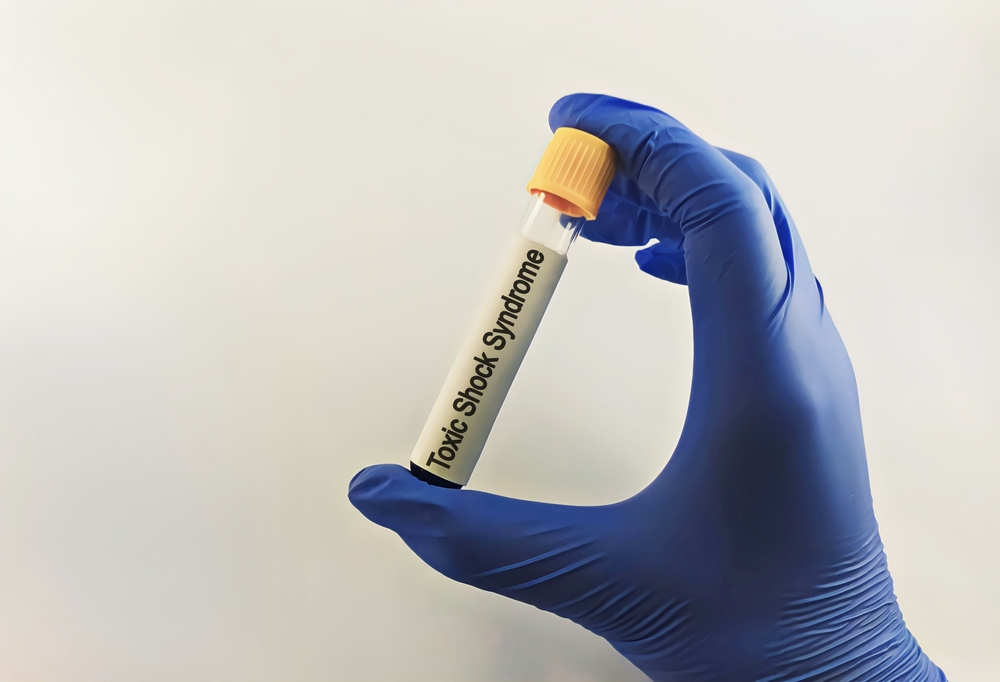Toxic shock syndrome (TSS) is a rare and life-threatening complication of certain types of bacterial infections. Most of us associate TSS with super-absorbent tampons. It is true that toxic shock syndrome is a possible side effect (albeit, an extremely rare one) of leaving a tampon in too long. As one woman learned, however, tampons are not the only way to develop the potentially fatal condition.
What is Toxic Shock Syndrome?

Toxic shock syndrome can occur as a result of a bacterial infection. Typically, Staphylococcus aureus (staph) bacteria are the cause, however, group A streptococcus (strep) bacteria may cause it as well.
While we often associate TSS with using tampons, it can affect anyone- including men and children. It occurs when the aforementioned bacteria enter your bloodstream. This can happen in many ways. Risk factors for TSS include:
- Cuts or burns on your skin
- Recent surgery
- Using contraceptive sponges, diaphragms, superabsorbent tampons, or menstrual cups
- A viral infection like the flu or chickenpox [1].
Toxic shock syndrome can progress very rapidly, and could cause the following complications:
- liver failure
- kidney failure
- heart failure
- shock, or reduced blood flow through the body [2]
There are many possible signs and symptoms of toxic shock syndrome, including:
- A sudden high fever
- Low blood pressure
- Vomiting or diarrhea
- A rash resembling a sunburn, particularly on your palms and soles
- Confusion
- Muscle aches
- Redness of your eyes, mouth, and throat
- Seizures
- Headaches [1]
Read More: Sorry Ladies, But It’s Not Supposed to Smell Like Flowers
Kandis’ Story

Like most of us, Kandis Saville-Parsons associated toxic shock syndrome with leaving a super-absorbent tampon in for too long. As a former nurse, she was aware that it could happen for other reasons, but she never considered that it might happen to her.
Her story began on July 24, 2018, when she decided to go to the nail salon for a manicure and pedicure to unwind. The nail technician accidentally cut her left big toe during her treatment. Saville-Parsons lives with type 1 diabetes, so she knew that the cut likely wouldn’t heal very quickly. Aside from that, however, she wasn’t too worried about the injury.
She certainly wasn’t worried about toxic shock syndrome.

As the day wore on, however, her toe started to swell and turn red. The next morning, it was nearly double its usual size, so she and her husband went straight to the hospital. There, the doctors ran a number of tests and gave her some strong antibiotics. If her condition worsened, they told her to come back. That night, her toe turned black and she spiked a fever of 106 degrees Fahrenheit.
A specialist at the hospital determined that the infection had moved into her bone, so two days after her pedicure, doctors amputated the young mother’s toe. “As my foot healed, I tried to get on with my life the best I could and continued to receive IV antibiotics to fight the infection,” said Saville-Parsons. “Unfortunately, a few weeks into my recovery, my health took a turn for the worse.” [3]
She had swelling all over her body, her back was hurting, and it was very difficult to pee. When she did, her pee looked like the color of cola. Saville-Parsons returned to the hospital, this time for weeks. It was clear that her kidneys were failing, but the medical team could not figure out why. Finally, her doctor did a full-body exam during which he found red rashes all over her body. He also found peeling skin in her ears and belly button. It was then that he realized she had toxic shock syndrome.
Read More: 5 Major Feminine Hygiene Mistakes That Can Affect Women’s Health
Life After Toxic Shock Syndrome

Saville-Parsons found out she had toxic shock syndrome three months after her toe injury. The doctors hadn’t been looking for TSS, because it is so incredibly rare. In fact, only one to three in one hundred thousand Americans develop it [4]. That’s only 0.001 to 0.003 percent of the population.
Ever since her diagnosis, the young mom has been on dialysis three times per week. With each session lasting four hours, that means she is spending twelve hours per week doing dialysis treatments. There is no hope that her kidneys will get better, so her name is now on the kidney transplant list.
“I also get lots of migraines, have to deal with nausea and vomiting, and spend a lot of time sleeping and crying,” she said. “But every day I remind myself that I have to keep fighting for my little boy and my husband.” [3]
What Saville-Parsons Wants You to Know

Despite how rare toxic shock syndrome is, she knows that it could have been prevented. As a person with diabetes, she knew she was at a higher risk for a foot infection, and that getting work done on her feet has more potential to go wrong.
“I know how wild and rare my story is. Not every random cut is going to lead to some nightmarish health situation, and that’s not my takeaway. Instead, I’ve learned that you should always be your own advocate when it comes to your health, and if you know something’s wrong, persist until you get the help that you need.” [3]
Looking back on it, Saville-Parsons wishes that she had stayed in the hospital and pressed harder for answers right from the beginning. She can’t change what happened to her, but she can encourage others to fight for themselves and their health. Doing so can prevent life-altering complications.
Read More: Are Tampons Safe? The Risks and Alternatives Every Woman Needs to Know

